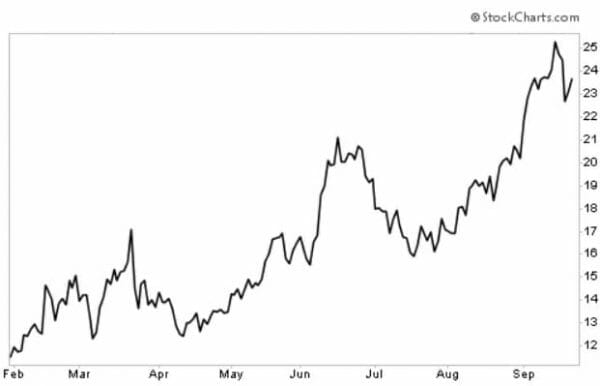High Yields Are Still Out There… (Here’s What You Could Be Earning)
$48,117. That’s the increase in my High-Yield Investing portfolio over the past 12 months. In the October 2020 issue, the balance stood at $106,250. As I’m writing this, we’re looking at a value of $151,373. That’s a 12-month return of about 45%.
The market has provided a nice tailwind over this time frame, with the benchmark S&P 500 gaining 35.7%. I’m happy to say we’ve matched that return and then some — outrunning the market by nearly 1,000 basis points.
That won’t always be the case. Considering we don’t invest in growth stocks like Apple or Google (and have a sizeable allocation of municipal bonds, preferreds, and other fixed-income securities), the S&P 500 isn’t the best yardstick to measure our performance. In fact, only five of my 45 active holdings are S&P members.
The yield on this popular basket of stocks has sunk to 1.25%. So out of necessity, I must look outside its borders for high-yield portfolio candidates. That generally means small/mid-cap territory, where richer payouts of 4% or higher are more plentiful.
Your average investor has never heard of the stocks, funds, and other securities we talk about in High-Yield Investing. They don’t get a lot of coverage in the mainstream financial media. But that’s fine with me. While behemoths like Wal-Mart are closely scrutinized by Wall Street analysts, smaller businesses are less followed and more lightly traded – a combination that leaves many quality stocks trading at steep discounts to fair value.
Coincidentally, the aforementioned October 2020 issue was a clarion call for investing in small caps. Since then, this overlooked corner of the market has shined. At the same time, a long-overdue rotation into value has also worked in our favor and bolstered performance. At the intersection of these trends lies stocks like the global shipping company I profiled, which has doubled since we pounced on it last January.

I’ve already recycled some of these gains, which have given our High-Yield Investing portfolio greater income-producing capacity. For illustrative purposes, let’s suppose I deposited the entire $154,367 in a one-year bank CD paying the national average of 0.17%. At that rate, we would earn about $262 per year – or a whopping $22 per month. Add another zero to the principal, and even then we would earn just $220 per month… barely enough for a trip to the grocery store.
Our mission is to help your money work harder. How much harder? Well, for the first time I’ve decided to assemble that information in a spreadsheet. Here are the total dividend distributions (or “paychecks”) we can expect to receive over the next 30 days.
Holding |
# shares |
Expected Div. or Int. Payment |
Total Distribution |
|---|---|---|---|
| Energy midstream | 272 |
$0.27 |
$73.44 |
| Commercial REIT | 40 |
$0.24 |
$9.60 |
| Energy MLP | 89 |
$0.45 |
$40.05 |
| Big Pharma | 75 |
$0.39 |
$29.25 |
| Energy giant | 50 |
$0.43 |
$21.50 |
| Ag mortgage company | 50 |
$0.88 |
$44.00 |
| Datacenter REIT | 25 |
$1.27 |
$31.75 |
| BDC | 115 |
$0.21 |
$24.15 |
| Casino REIT | 100 |
$0.33 |
$33.00 |
| Mortgage insurer | 50 |
$0.36 |
$18.00 |
| Fast-food conglomerate | 60 |
$0.53 |
$31.80 |
| Hotel preferred stock | 100 |
$0.41 |
$41.00 |
| Mortgage REIT | 100 |
$0.62 |
$62.00 |
| Energy/MLP fund | 150 |
$0.18 |
$27.00 |
| Shipping preferred stock | 186 |
$0.55 |
$102.30 |
| Oil & gas midstream | 75 |
$0.94 |
$70.50 |
| Covered call fund | 100 |
$0.13 |
$13.00 |
| Dividend fund | 150 |
$0.11 |
$16.50 |
| Real asset fund | 100 |
$0.10 |
$10.00 |
| Enhanced income fund | 300 |
$0.05 |
$15.00 |
| Premium dividend fund | 142 |
$0.10 |
$14.20 |
| Healthcare fund | 100 |
$0.11 |
$11.00 |
| Muni bond fund | 150 |
$0.05 |
$7.50 |
| Commodities fund | 300 |
$0.04 |
$12.00 |
| Emerging markets fund | 45 |
$0.64 |
$28.80 |
| Utilities fund | 100 |
$0.12 |
$12.00 |
| Canadian telecom | 100 |
$0.72 |
$72.00 |
Total |
$871.34 |
I don’t bring all this up to brag. The point is that even in this historically low-yield environment, we will still collect a healthy $871 next month. That’s roughly 40 times more than the income from a bank CD.
The average retired worker collects a $1,553.68 check each month from Social Security, according to the Social Security Administration. So that’s already 50% more each month right there, for a total of $2,424.68. That could get the job done in retirement, depending on your situation.
But the good news is this… When most of my High-Yield Investing readers retire, they’re sitting on a bigger portfolio than $154,367.
Let’s say you add a zero back on to our portfolio size again. At $1.54 million, you’re looking at $8,710 per month. That’s more than enough for most of us.
Regardless of where you’re at, this should be proof-positive that you don’t necessarily need to reach for risky “growth” stocks to make up for lost time. A stable of quality dividend payers can make you rich over time.
And that’s where my latest report comes in…
I’ve handpicked 5 of my absolute favorite dividend payers for a very special purpose. Each one of these is what I consider to be “bulletproof” – meaning you can build your portfolio around them, sleep well at night, and watch the income roll in year after year.
